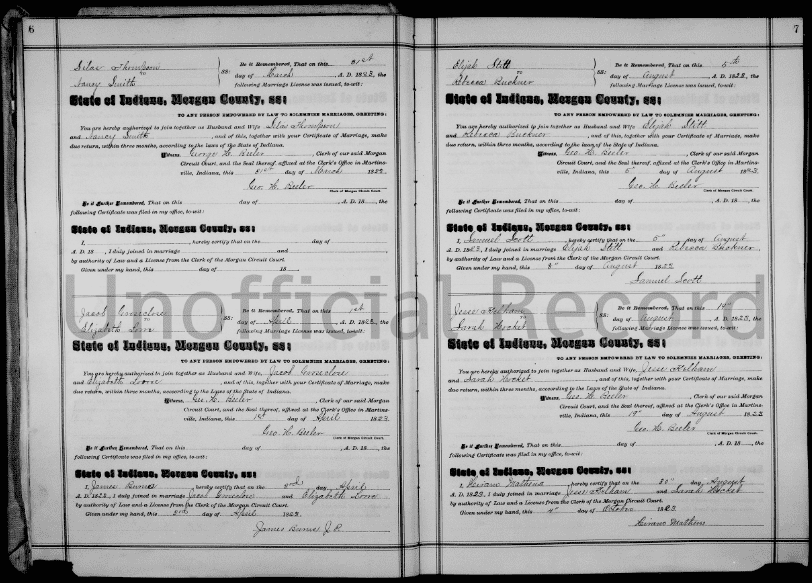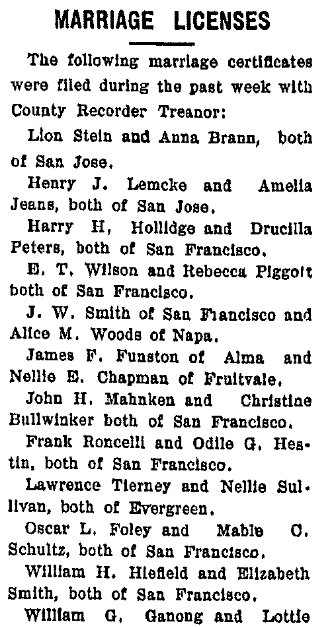Introduction: In this article – part of an ongoing “Introduction to Genealogy” series – Gena Philibert-Ortega discusses one of the most important family history records: marriage licenses. Gena is a genealogist and author of the book “From the Family Kitchen.”
Why do genealogists search for marriage records? Genealogy is about confirming relationships through the generations. One way to confirm relationships is to verify a marriage between two families. Marriage records, such as marriage licenses, provide the tool to do that.
Now, am I saying that everyone who had a child married? No, of course not – but when we are connecting children to their parents, one source we look at are marriage records.
So how do you start your search for the facts about your ancestor’s marriage? Read on for ideas of what’s available and how to find those records.

Why Marriage Licenses?
Marriages, depending on the time period and place, can mean a whole host of different records. For our purposes here, let’s discuss the most common record: a marriage license, that when executed may also include a marriage certificate.
Marriage licenses were issued by a government authority like a county clerk, and instructed the person who would marry the couple that they were able to do so. Once the marriage took place, the officiant signed the license. Then that license was returned to the authority that issued it and a certificate may have been issued (or the certificate/license is one form).
Genealogy Tip: local newspapers often printed lists of recently-granted marriage licenses, so be sure to include this search in your newspaper research.

Now, one word of warning: everyone who applied for a marriage license didn’t end up getting married. So, we would hope to find other evidence, including the marriage certificate, to prove the marriage actually took place.
Who Has a Marriage License?
Marriage licenses replaced early marriage permissions (like Banns), so whether your ancestor had a marriage license depends on the time and place they married. See the chart below for a guideline of years that states issued marriage licenses/certificates.
Marriage License Availability
| Alabama
1936 |
Alaska (sealed for 50 years)
1913 |
Arizona
1909 |
Arkansas 1917 | California 1905 |
| Colorado 1907 | Connecticut 1897 | Delaware 1847 | Florida 1927 | Georgia 1952 |
| Hawaii 1842 | Idaho 1947 | Illinois 1962 | Indiana 1958 | Iowa 1880 |
| Kansas 1913 | Kentucky 1958 | Louisiana 1870 | Maine 1892 | Maryland 1950 |
| Massachusetts 1841 | Michigan 1867 | Minnesota 1958 | Mississippi 1926 | Missouri 1881 |
| Montana 1943 | Nebraska 1909 | Nevada 1968 | New Hampshire 1883 (1640 from town clerk) | New Jersey 1848 |
| New Mexico 1920 | New York 1880 | North Carolina 1962 | North Dakota 1925 | Ohio 1949 |
| Oklahoma 1908 | Oregon 1906 | Pennsylvania 1885 | Rhode Island 1853 | South Carolina 1950 |
| South Dakota 1905 | Tennessee
1945 |
Texas
1966 |
Utah
1887 |
Vermont
1955 |
| Virginia 1912 | Washington 1968 | West Virginia 1964 | Wisconsin 1907 | Wyoming
1941 |
Please note that some counties or cities started recording births much earlier than their parent state. So always check the county your ancestor married in. In New England, vital records may be kept on the town level. Interruptions (like war) can also occur with vital record registration, leaving some births not recorded. The District of Columbia started vital records registration in 1861.**
Where Are Marriage Records?
Marriage announcements, lists of recently-granted marriage licenses, and details about specific weddings can all be found in the pages of old newspapers, such as GenealogyBank’s online Historical Newspaper Archives. Make sure when you search for marriage license and engagement information that you search by the bride’s maiden name as well as the groom’s name.
Another excellent place to find marriage records is FamilySearch. Start by searching the FamilySearch Catalog by place and then by subject, such as Vital Records and Vital Records –Indexes. You can also search the Historical Records collection on FamilySearch by clicking on Search>Records and then choosing a place to find what digital marriage record images and indexes are available.
A great feature of FamilySearch’s Family History Research Wiki is individual wiki pages that provide information about where to find marriage records for each state. Consult the How to Find United States Marriage Records wiki page and then choose the state link you are researching.
Where else might you find marriage records? Subscription and government-run websites should be checked next. A helpful finding aid to websites with marriage records can be found on the Online Birth & Marriage Records Indexes of the USA website.
Another approach in your search for marital proof is to contact the state or county recorder’s office for a copy of the marriage license and certificate. To get information about state vital records see the Center for Disease Control and Prevention’s Where to Write for Vital Records web page. I highly recommend finding the county vital record office website and starting your search there first. Often ordering through a county will be quicker than through a state office.***
Start Searching for Marriage Records Today!
Marriage licenses are just one type of marriage record available. My next article, on Marriage Record Alternatives, will provide more information about other types of marriage records and alternatives.
————————–
* “Indiana Marriages, 1811-2007,” database with images, FamilySearch (https://familysearch.org/ark:/61903/3:1:3QSQ-G9XF-W8SJ?cc=1410397&wc=Q83F-HBF%3A963066801%2C1067899602: 21 January 2016), Morgan > image 38 of 328; County clerk offices, Indiana.
** Vitalrec.com; FamilySearch Family History Research Wiki; Family Tree Magazine Vital Records Chart.
*** I’m using the word “county” here generically. “Counties” in Louisiana are called “Parishes” and in Alaska they are “Boroughs.”
